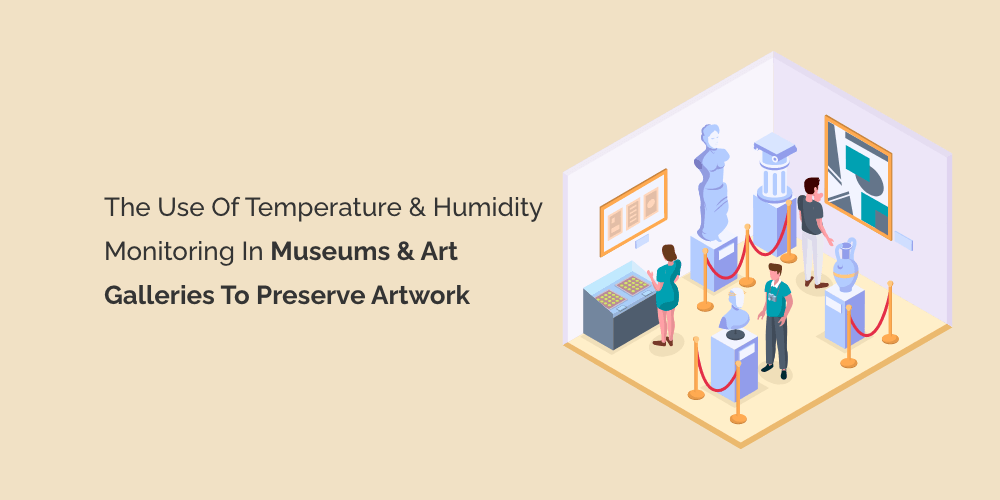Hello, art lovers! As an expert in art and museum management with over 20 years of experience, I am delighted to share with you my insights on the critical role of temperature and humidity monitoring in museums and art galleries.
You may wonder why something as seemingly mundane as temperature and humidity control is so crucial in preserving art pieces. The truth is that artworks are incredibly sensitive to their environment, and even minor changes in temperature and humidity levels can cause significant damage. As a result, proper environmental control is essential in maintaining the integrity and longevity of art pieces.
Allow me to take you on a journey through the world of museum and art gallery management as we explore the importance of temperature and humidity monitoring and how it is done.
Temperature Monitoring
First and foremost, let's talk about temperature. Art pieces are incredibly sensitive to temperature changes and can easily become damaged if exposed to extreme heat or cold. For example, oil paintings can crack and fade in high temperatures, while low temperatures can cause the canvases to become brittle and flaky.
That's why it's crucial to maintain a stable temperature within museums and art galleries. The ideal temperature range for most art pieces is between 18 and 22 degrees Celsius, with a maximum fluctuation of 1 degree per day.
But how do we ensure that the temperature remains constant? The answer lies in temperature monitoring devices.
There are various types of temperature monitoring devices available, such as wifi monitors, data loggers, thermocouples, and infrared sensors. These devices are placed in strategic locations throughout the museum or gallery, such as storage rooms, exhibition halls, and even in transit during transportation.
Once in place, the temperature monitoring devices continuously measure and record the temperature levels, sending alerts if there are any deviations from the desired range. This information is then analyzed and used to make adjustments to the environment, such as adjusting air conditioning or heating systems.
Humidity Monitoring
Moving on to humidity, it's important to note that moisture can be just as damaging to art pieces as extreme temperatures. High humidity can cause mold and mildew growth, while low humidity can cause shrinkage and crack in some materials.
The ideal humidity range for most art pieces is between 45% and 55%, with a maximum fluctuation of 5% per day. However, certain types of artwork, such as watercolors and prints, require even tighter humidity control, with a range of 40% to 50%.
As with temperature monitoring, there are various types of humidity monitoring devices available, such as capacitive sensors, dew point sensors, and psychrometers. These devices are placed strategically throughout the museum or gallery, measuring and recording humidity levels in real time.
Similar to temperature monitoring, alerts are sent out if the humidity levels fall outside of the desired range, and adjustments are made to the environment to correct the issue.
Other Factors to Consider
While temperature and humidity are the primary factors to consider when it comes to preserving artwork, other environmental factors must also be taken into account.
Lighting: Excessive exposure to light can cause fading and discoloration in the artwork. That's why museums and galleries use special lighting that emits low levels of UV radiation and filters that block out harmful light wavelengths.
Air Quality: Air pollutants can damage artwork over time. Museums and galleries use specialized air filtration systems to maintain safe air quality levels for art pieces.
Storage: Even with the best temperature and humidity control systems in place, artwork must also be stored properly to prevent damage. Art pieces should be kept in acid-free containers and stored in a secure location and away from direct sunlight.
In conclusion, temperature and humidity monitoring is essential in the preservation of artwork in museums and art galleries. By maintaining stable temperature and humidity levels, museums and galleries can ensure that art pieces remain in excellent condition for generations to come.
As someone who has dedicated their career to managing and preserving art collections, I cannot stress the importance of proper environmental control enough. It's not just about the present condition of the artwork but also about ensuring that they remain in excellent condition for future generations to appreciate and enjoy.
Of course, temperature and humidity monitoring is just one aspect of art collection management. There are many other factors to consider, such as proper handling, storage, and transportation. However, it's undeniable that temperature and humidity control is one of the most critical aspects of preserving artwork.
As technology advances, we can expect to see even more sophisticated temperature and humidity monitoring systems that can provide even greater levels of accuracy and control. But even with these advancements, it's important to remember that there is no substitute for the knowledge and experience of art collection managers.
Ultimately, the preservation of artwork is a delicate balancing act between maintaining the integrity of the art piece and allowing people to appreciate and enjoy them. With proper temperature and humidity monitoring, museums and galleries can strike that balance and ensure that artwork remains a vital and meaningful part of our cultural heritage for generations.
I hope this article has given you some insights into the importance of temperature and humidity monitoring in the preservation of artwork. As someone who is passionate about art and its preservation, it's essential that we all work together to ensure that future generations can continue to enjoy the beauty and significance of art pieces from around the world.
Author Name: Artie Fahrenheit
About the Author: Artie Fahrenheit is an eccentric art enthusiast and museum curator who has spent the past 25 years ensuring that art pieces stay safe and cool, literally. When he's not geeking out over environmental control systems, you can find Artie exploring the latest art exhibitions or playing guitar in his garage band. His quirky personality and love for all things art make him a favorite among museum staff and visitors alike.








